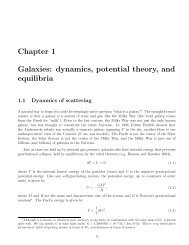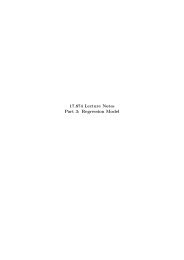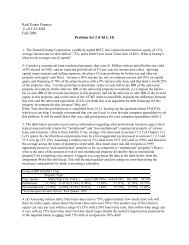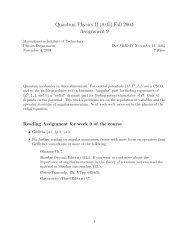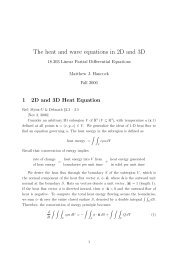INDISTINGUISHABLE PARTICLES: Where does the N! come from ...
INDISTINGUISHABLE PARTICLES: Where does the N! come from ...
INDISTINGUISHABLE PARTICLES: Where does the N! come from ...
You also want an ePaper? Increase the reach of your titles
YUMPU automatically turns print PDFs into web optimized ePapers that Google loves.
where Z is <strong>the</strong> grand canonical partition function <strong>the</strong> sum is over all possible quantum states of <strong>the</strong> system, with all possible numbers of particles.<strong>the</strong> chemical potential, which is strictly defined asisbut you may be more familiar with <strong>the</strong> continuous approximationwhich is valid for macroscopic systems (large N). Note that by induction<strong>Where</strong> <strong>the</strong> sum is over n <strong>from</strong> 1 to N. The expected number of particles in <strong>the</strong> system
We can rearrange this to i.e. this is <strong>the</strong> chemical potential that a reservoir must have for it to be in equilibrium with an ideal gassystem with N particles in a volume V at temperature T. Now we can add up all <strong>the</strong>values as we add particles to an empty system <strong>from</strong> n=1 to N to get <strong>the</strong> free energy of <strong>the</strong> system:We can evaluate <strong>the</strong> sum (a sum of ln's is a product): and <strong>the</strong> term in brackets is indeed Q (since F=-kT ln Q). So <strong>the</strong> N! is exactly right (at least for an idealgas).Non-ideal gases:To get <strong>the</strong> partition function for a non-ideal gas where you know P(T,V,N) and <strong>the</strong> behavior in <strong>the</strong> dilute(ideal-gas) limit, say at volume Vo, one can perform an integral over volume:so
What <strong>does</strong> <strong>the</strong> N! have to do with Keq?At equilibrium <strong>the</strong> free energy <strong>does</strong> not change when a chemical reaction proceeds a little (if <strong>the</strong>chemical reaction proceeds a lot, <strong>the</strong> concentrations in <strong>the</strong> system will move appreciably away <strong>from</strong>equilbrium). In o<strong>the</strong>r words, <strong>the</strong> sum of <strong>the</strong> chemical potentials of <strong>the</strong> reactants (weighted by anystoichiometric coefficients) must equal <strong>the</strong> sum of <strong>the</strong> chemical potentials of <strong>the</strong> products (again,weighted by any stoichiometric coefficients).Above, for an ideal gas, we foundso at equilibrium for a reaction A+B = C at constant volume (A,B,C assumed ideal)ln(N a N b /q a q b ) = ln(N c /q c )which can be re-arranged to[C]/[A][B] = (6.02E23 molecules/mole) (q c /V)/(q a /V)(q b /V)If <strong>the</strong>re is some kinetic inhibition, and <strong>the</strong> reaction <strong>does</strong> not equilibrate completely (but <strong>the</strong> temperature<strong>does</strong>), one can still compute <strong>the</strong> change in free energy associated with <strong>the</strong> progress of <strong>the</strong> reaction using<strong>the</strong> expression for <strong>the</strong> chemical potential or for F given above.







